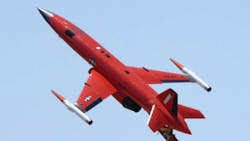Kratos to build target drones to help combat aircraft pilots practice the launch of air-to-air missiles
EGLIN AIR FORCE BASE, Fla. – Kratos Unmanned Aerial Systems Inc., Sacramento, Calif., will build BQM-167A Air Force Subscale Aerial Target (AFSAT) drones under terms of a potential $338.1 million U.S. Air Force contract announced Friday.
Officials of the Air Force Life Cycle Management Center at Eglin Air Force Base, Fla., are asking Kratos to build lots 17 to 21 of the BQM-167A aerial target drones. The contract includes out-of-warranty-repairs and contractor logistics support.
The BQM-167A provides Air Force combat aircraft pilots to practice launching air-to-air missiles. The drone carriers 115 gallons of fuel to enable the unmanned aircraft to operate for long periods, which increases the number of presentations per launch, Kratos officials say.
The BQM-167A supports missions with a several different internal and external payloads, including scoring, identification friend or foe (IFF), passive and active radar augmentation, electronic countermeasures, infrared plume pods, and internally stored chaff and flares.
The BQM-167A AFSAT is a high-performance, remotely controlled subscale aerial target drone that helps combat aircraft pilots prove the value of advanced air-to-air weapons. Kratos builds the BQM-167A of carbon fiber and epoxy-based materials that help increase performance and endurance compared to previous targets, which were built mainly of aluminum, Air Force officials say.
The BQM-167A can reach speeds from 230 to 600 knots true airspeed at sea level, and can perform G-turns to 9Gs, and other aerial acrobatic turns that emulate high-performance jet fighter aircraft.
The drone is 10 feet long, has a 10.5-foot wingspan, can fly nearly at the speed of sound, and operates at altitudes from 50 feet to 50,000 feet above sea level.
Experts from the Air Force 53rd Weapons Evaluation Group at Tyndall Air Force Base, Fla., will use the BQM-167A target drones to test and evaluate air-to-air weapon systems and for evaluation and training exercises on the Gulf Range Complex and other authorized U.S. military test ranges.
For more information contact Kratos Unmanned Aerial Systems online at www.kratosdefense.com, or the Air Force Life Cycle Management Center at www.aflcmc.af.mil.

John Keller | Editor-in-Chief
John Keller is the Editor-in-Chief, Military & Aerospace Electronics Magazine--provides extensive coverage and analysis of enabling electronics and optoelectronic technologies in military, space and commercial aviation applications. John has been a member of the Military & Aerospace Electronics staff since 1989 and chief editor since 1995.

